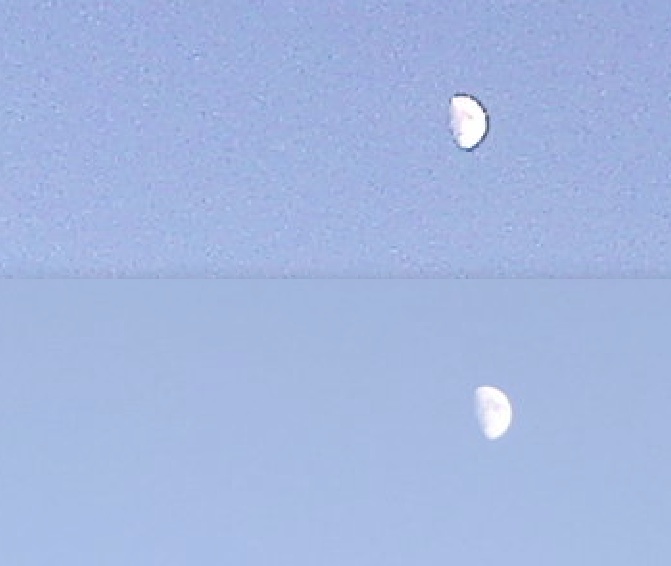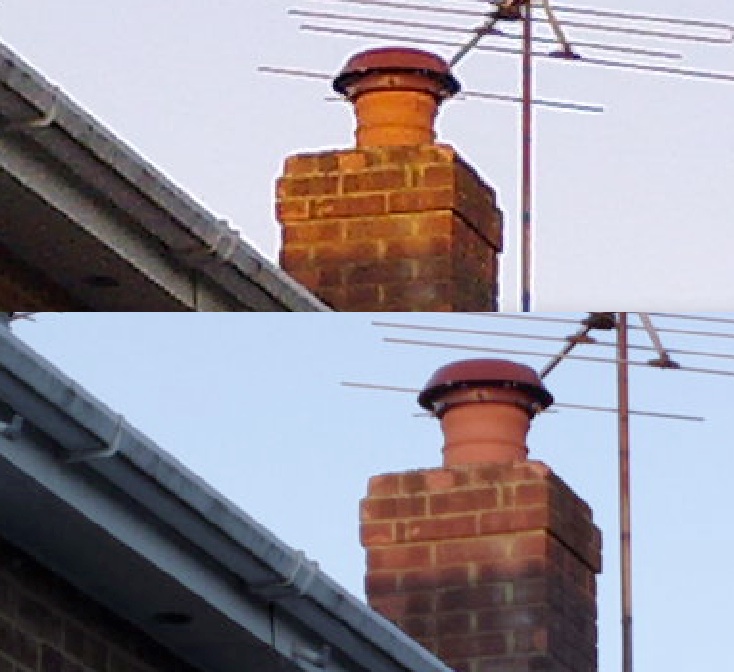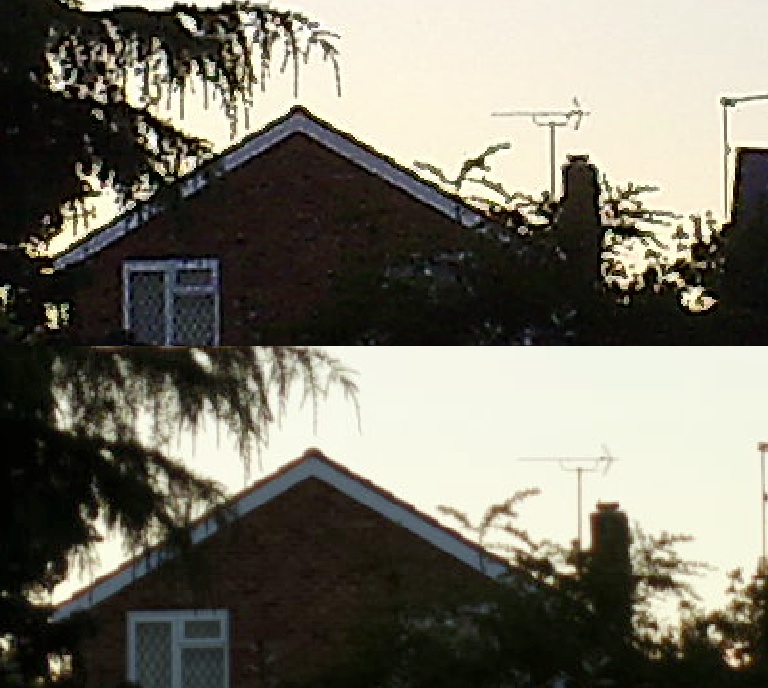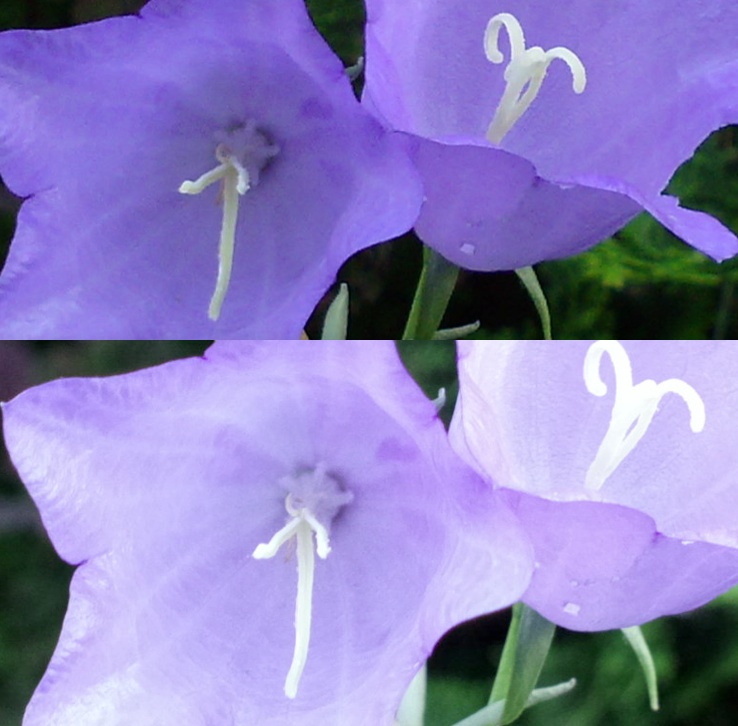It's no test of these phone cameras if I shoot photos in sunlight - both the N86 and 808 claim to specialise in challenging light conditions, so why not test them as such? The N86 has variable aperture and can go down to F2.4, which is wide for the day (2009), plus a big 1/2.3" sensor, while the 808 famously has an enormous sensor, at 1/1.2", plus it's fixed at F2.4, so should be even better.
In each case, as requested, I used the 808's '8MP PureView' mode throughout.
Test 1: Moon in dusk sky
Let's start with the most challenging task of all, picking details out on the moon in a flawless dusk sky. The N86 was put in 'landscape' mode - the 808 had to be focussed on the most distant part of the treeline (I wasn't confident even the 808 could focus on the moon!!). I then cropped in so you can see the difference. In each case, the N86's photo crop is on top, the 808's on the bottom:

Quite a difference. Although there's little more actual usable detail, the difference in sensor noise is massive. Remember that the purity of the 808's image is not down to noise-reduction in software on a snapped image - the noise reduction comes at the very lowest level as part of the PureView oversampling on the 41 megapixel sensor.
In contrast, the N86's sensor noise and sharpening algorithms are very much evident. This one test crop speaks volumes and sets the tone for the rest of this comparison. Much as I love the N86, it's simply outclassed here once you look closely, with one exception (which I'll leave to last).
Test 2: TV Aerial and roofline
A nice opportunity to pick out detail on something around 10 metres away, in this case a TV aerial and roofline of the neighbouring house, in the setting sun. As before, the N86's photo crop is on top, the 808's on the bottom:

It's true that there's a warmth in the N86's photo crop, but other than the colour temperature there's simply no comparison. Look at any detail and you'll see a natural look to the 808 photo's lines and a noisy, over-processed look to the N86's photo. Remember that this was right before sunset and light levels were low - the 808 did amazingly well to still produce noise-free blocks of white on the soffit and fascia. Plus the aerial wires look utterly real in the crop below.
Test 3: Horizon
What about looking to where there's most light, right on the horizon in front of the setting sun? As before, the N86's photo crop is on top, the 808's on the bottom:

I've cropped in quite a lot here, as you can see. The N86's post-processing is really quite ugly - snapping things so far away really isn't its speciality. In contrast the 808's photo only has marginally more detail but is far more natural. And I suspect that if I'd used a tripod to keep the 808 rock solid then I could have produced even sharper results.
Test 4: Low light flower
Nestling in the dusk was a flower, which I tried snapping despite the low light levels. As before, the N86's photo crop is on top, the 808's on the bottom:

Now we're back in the N86's comfort zone - it really does seem optimised for close-up photography, some of my very best flower photos have been on the N86, which handles extremes of light well and which allows incredibly precise focussing. Even the sharpening only serves to enhance the detail on the plant. In contrast, the Nokia 808 PureView over compensates in terms of exposure and the petals are shown as whiter than they really were. I'm confident that with a little tweaking I could have managed a better match with reality and, ultimately, a better photo on the 808, but for now, I'll hand this round to the N86.
Summary
The N86 has its place in Nokia's string of camera-specialist smartphones, slotting in between the N82 and N8 and somewhat diminished by not having a Xenon flash. It tried to make up for this with the variable aperture and larger sensor, but ultimately I think Nokia made a mistake by applying too much sharpening, as was popular in the industry (and still is in other manufacturer's products).
For the N8, Nokia famously went down the line of showing the photo as it was, completely naturally. The risk was that casual perusal would see the photo as 'less crisp', but having a fully natural photo meant that small details weren't obscured by purely digital processing artefacts, so you could do more in terms of cropping the images later and still getting good results. The 808 keeps the same philosophy, producing utterly natural as-is photos. Leaving it up to the user to apply sharpening later on if needed.
Obviously, I'd place the 808 as a better camera phone than the N86 overall, but the latter does still manage credit for producing instantly satisfying close-up photos.
Purely for amusement and reader interest, I also thought I'd put scores to the stills cameras in a range of smartphones that I've tried. Just for fun, note, the list isn't definitive, please don't start a comment war over the numbers!
- 90% - Nokia 808 PureView
- 82% - Nokia N8
- 73% - Apple iPhone 4S
- 71% - HTC One X, Samsung Galaxy S II, III
- 67% - Nokia N82
- 66% - Nokia N86
- 60% - Nokia N95/N96/N97
- 57% - Motorola Milestone XT720
- 55% - Apple iPhone 4
- 54% - Nokia N93
